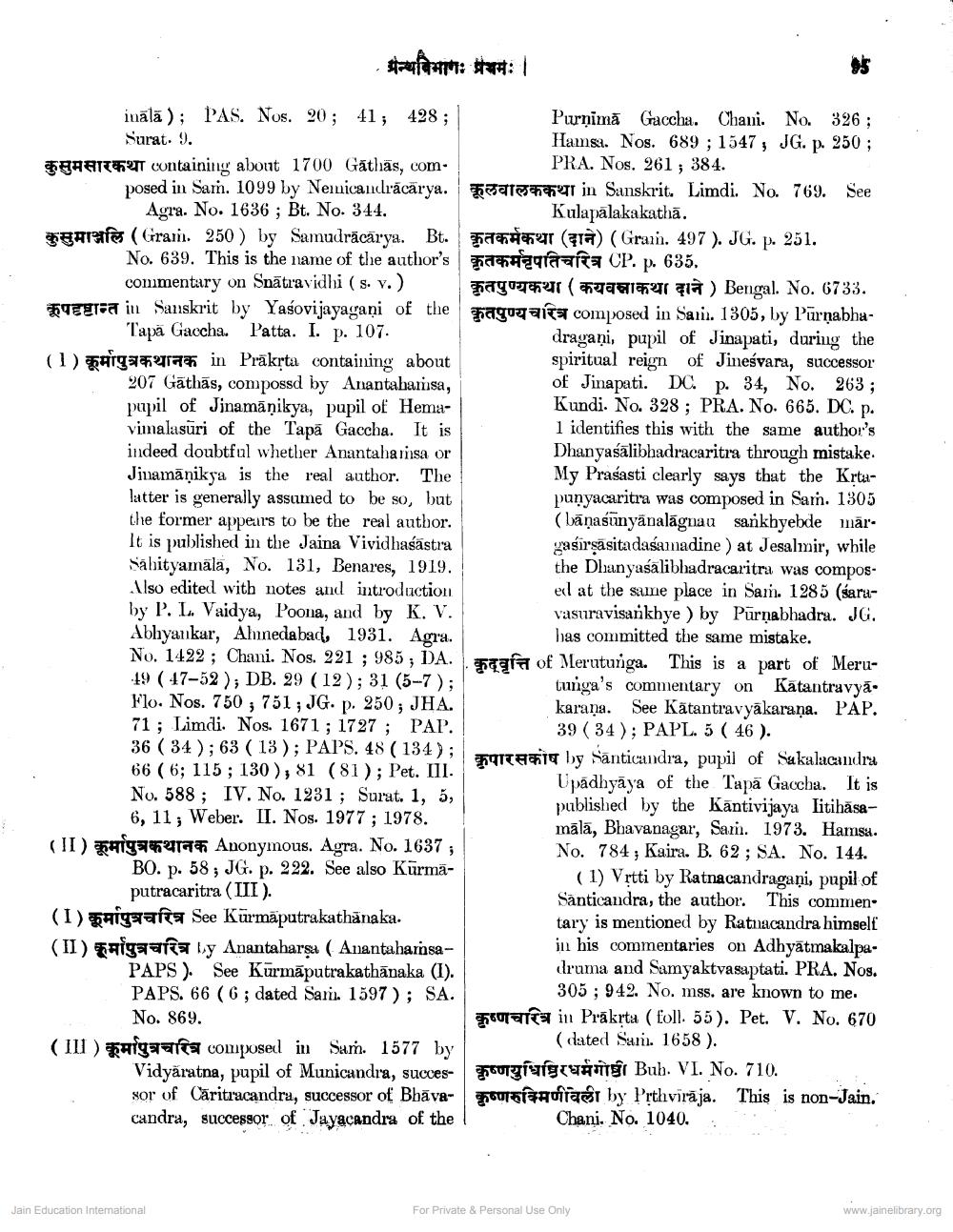________________
- H
arim:
: 1
inālā); PAS. Nos. 20; 41; 428 ;
Purnimă Gaccha. Chani. No. 326; Surat. 9.
Hams. Nos. 689 ; 1547, JG. p. 250 ; FRATTUT containing about 1700 Gathas, com.
PRA. Nos. 261 ; 384. posed in Sam. 1099 by Nemicandrācārya. Kali in Sanskrit. Limdi. No. 769. See Agra. No. 1636; Bt. No. 344.
Kulapālakakathā. EANS (Gram. 250 ) by Samudräcārya. Bt. Batur (aa) (Grann. 497). JG. p. 251.
No. 639. This is the name of the author's agraarta CP. p. 635.
commentary on Snātravidhi ( s. y.) Bagozkur ( 1012 ) Bengal. No. 6733. TEUT-a in Sanskrit by Yasovijayagani of the fagozats composed in Sari. 1305, by PurnabhaTapā Gaccha. Patta. I. p. 107.
drayani, pupil of Jinapati, during the (1) कूर्मापुत्रकथानक in Prakrta containing about
spiritual reign of Jineśvara, successor 207 Gāthās, compossd by Anantabarisa,
of Jinapati. DC p. 34, No. 263; papil of Jinamāņikya, pupil of Hema
Kundi. No. 328 ; PRA. No. 665. DC. p. vimalasuri of the Tapā Gaccha. It is
1 identifies this with the same author's indeed doubtful whether Anantaharsa or
Dhanyaśālibhadracaritra through mistake. Jinamāņikya is the real author. The
My Prasasti clearly says that the Krtulatter is generally assumed to be so, but
punyacaritra was composed in Sam. 1305 the former appears to be the real author.
(bānasünyānalāgnau sankhyebde märIt is published in the Jaina Vividhasastra
yasirşāsitadasamadine ) at Jesalmir, while Sahityamāla, No. 131, Benares, 1919.
the Dhanyaśālibhadracaritra was composUso edited with notes and introduction
ed at the same place in Sam. 1285 (baruby P. L. Vaidya, Poona, and by K. V.
vasuravisankhye ) by Purņabhadra. JG. Abhyankar, Ahnedabad, 1931. Agra.
has committed the same mistake. No. 1422 ; Chani. Nos. 221 ; 985 ; DA. agra of Meruturiga. This is a part of Meru19 ( 47-52); DB. 29 (12); 31 (5-7);
tunga's commentary on Katantravya. Flo. Nos. 750 ; 751; JG. p. 250; JHA.
karana. See Kätantravyākaraņa. PAP. 71 ; Limdi. Nos. 1671; 1727 ; PAP.
39 ( 34); PAPL. 5 ( 46 ). 36 (34); 63 ( 13 ); PAPS. 48 (134);
A T&T by Santicandra, pupil of Sakalacandra 66 ( 6; 115 ; 130 ), 81 (81); Pet. III.
Upadhyāya of the Tapā Gaccha. It is No. 588 ; IV. No. 1231 ; Surat. 1, 5,
published by the Kāntivijaya Iitihăsa6,11; Weber. II. Nos. 1977; 1978.
mālā, Bhavanagar, Sam. 1973. Hamsa. (JI) 477Anonymous. Agra. No. 1637 ;
No. 784; Kaira. B. 62 ; SA. No. 144. BO. p. 58; JG. p. 222. See also Kurmā
(1) Vrtti by Ratnacandragaņi, pupil of putracaritra (III).
Santicandra, the author. This commen (1) baigsafts See Kürmäputrakathānaka.
tary is mentioned by Ratnacandra himself (II) nigarily Anantaharsa (Anantaharsa
in his commentaries on AdhyatmakalpaPAPS). See Kūrmāputrakathānaka (I).
druma and Samyaktvasaptati. PRA. Nog. PAPS. 66 (6; dated Sari. 1597); SA.
305 ; 942. No. mss. are known to me. No. 869.
Foartea in Prākrta (foll. 55). Pet. V. No. 670 (111) agzati composed in Sań. 1577 by
(dated Sam. 1658 ). Vidyaratna, pupil of Municandra, succes- utgivgrung Buh. VI. No. 710. sor of Căritracandra, successor of Bhāva- pursigiasi by Prthvirāja. This is non-Jain. candra, successor of Jayacandra of the
Chani. No. 1040.
Jain Education Intemational
For Private & Personal Use Only
www.jainelibrary.org




